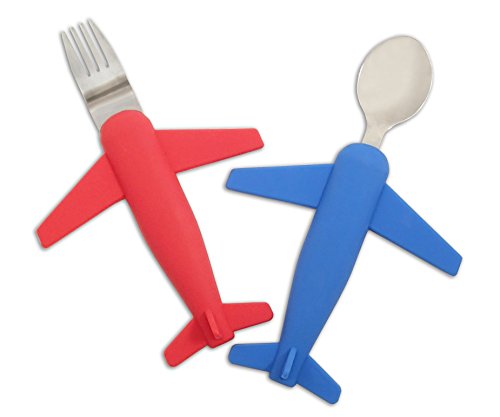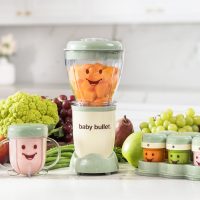One day, I had a baby who ate broccoli, cauliflower, and green beans. Another day, she started refusing to eat foods she once loved. I became concerned that she was not getting the nutrition she needed to grow healthy and strong. I came to learn that picky eating is common toddler behavior, and research shows that it rarely has a significant effect on a child’s growth. Below are tips and research to help your toddler get past this phase.
What Defines Picky Eating?
Before we get into the specifics, it is helpful to understand what the experts define as picky eating. According to pediatricians and feeding therapists, toddlers are prone to picky eating if they:
- Eat a limited amount of food
- Have strong food preferences
- Are unwilling to try new foods
- Have restricted intake, particularly of vegetables
If any of those describes your child, especially that last point, read on.
10 Tips to Help Your Toddler Eat Vegetables
To see a lot of our tips in action, head over to Experienced Mommy’s YouTube page. We have a whole video on how to get young children to eat their veggies. Don’t forget to hit the like and subscribe buttons for more videos like this one. Now let’s dive in!
1. Lay off the pressure
Perhaps you grew up hearing this at the dinner table:
“Let’s take one last bite!”
“No dessert until you finish your peas.”
“Just try the carrots. They’re really yummy. I know you’ll love it.”
These statements seem harmless. After all, you’re not force-feeding the vegetables into your kids’ mouths. But research shows that coercion can actually lead to pickier eating.
According to a study by the Frontiers in Pediatrics and published in the National Center for Biotechnology Information, pressuring kids to eat their vegetables can actually cause them to dislike those foods even more. Researchers found that kids gained acceptance of new foods when they were not coerced to try them.
This was eye-opening for me. I did not realize that my simple statements of what I thought was encouragement were actually doing the opposite of what I had hoped.
As challenging as it can be, many parents have found that taking the pressure off vegetables and any other disliked foods is actually quite liberating. All you are in charge of as a parent is to provide healthy, balanced meals and snacks on a predictable schedule. Your child’s job is to determine how much and what they want to eat. It takes the stress away at mealtimes.
Another reason we don’t want to pressure our kids to eat their vegetables is that we don’t want to hold veggies higher than any other foods. A balanced diet is key. Pediatricians recommend children eat vegetables, fruits, whole grains, protein, dairy, and more. Constantly pressuring kids, even toddlers (who understand and are more aware than we think), to eat their vegetables sends the message that veggies must be more important than everything else on their plate. We want them to enjoy and eat all food!
2. Repeated Exposure
It can be discouraging to serve vegetables at every meal and snack when they don’t get touched, but it is very important that toddlers are offered a variety of veggies throughout the day.
In a study of more than 3,000 children, researchers found that infants and toddlers needed as many as 8 to 15 exposures to a particular food before they gained acceptance of that food. Some kids, like my daughter, need way more than that.
That’s not to say that you should offer half a dozen vegetable choices to your toddler at every single meal and snack in hopes that they get comfortable with them. This can get overwhelming for toddlers. Instead, try offering a few vegetables, along with a food you know that they like and that they will eat. This is key. Offering a “safe food” along with something new or disliked helps young children feel more comfortable and more likely to try the unfamiliar.
Repeated exposure and consistently seeing a rotating cast of vegetables on their plates will help toddlers get used to them and help them understand that they are not so scary or “yucky” after all. It will take time, and it will test your patience. Just remember it is okay if your toddler gobbles up the chicken and doesn’t touch the vegetable. Repeat to yourself: your only job is to provide a healthy, balanced plate; your toddler’s job is to decide what and how much to eat.
3. Kid-Friendly Sizes and Portions
If you read the above tip and started panicking about all the food you’ll be wasting, you’re not alone. The idea of offering a certain kind of vegetable up to a dozen times before your toddler will even touch it can be maddening.
But keep in mind, toddlers need very small portions. In fact, when serving a vegetable that toddlers don’t like, place very few pieces on the plate. Picky eating is often referred to as “food neophobia,” or the fear of new food. Veggies that are cut small that they can easily put in their mouths are less overwhelming than seeing a huge mound of it.
As an example, I will put three tiny pieces of broccoli on my daughter’s plate at dinner time. Sometimes she will play with them (“They look like trees!” she’ll say). Sometimes she will lick them. Other times, she will chew it and then spit it out. All of these are great first steps. She knows that if she wants more, she can always ask for more.
4. Model Behavior
Family meals are so important, not just to build stronger relationships and bonds, but because it is shown to lead to less picky eating in children. Numerous studies have shown that young children more readily accept new or previously disliked foods when others around them are eating the same types of foods.
If you have toddlers, you know they want whatever you have. They don’t want their water bottle. They want mommy’s bottle filled with the same water. The same goes for food. I cannot tell you how many times my daughter has refused to try the veggie on her plate but will eat the one on mine because it was on my plate.
Once your child has mastered eating solid foods, try as best you can to have the entire family eat the same meal. (Fewer meals for you to prepare is a big win!) Of course, food for toddlers should still be cut up and prepared in ways that are developmentally safe.
As adults, we may have vegetables that we don’t like and won’t eat. But when you’re around toddlers and young children, my best advice is to put on a smile and eat it. Your kids are watching, and we need to lead by example.
5. Include Veggies Wherever You Can
If your child won’t eat any vegetables, you can ensure that you are meeting their nutritional needs by including vegetables in the foods they will eat. Think smoothies, pasta sauces, dips, and more!
Adding vegetables to some of your child’s favorite foods may work up until a certain point. Toddlers may not know the difference. But if you have older children who are struggling with picky eating, I would be mindful of not “sneaking in” vegetables. Older kids are more aware and not much fools them, so this plan could completely backfire. They could feel tricked and that could erode their trust.
To avoid this scenario, I would be very upfront with what ingredients you are including, so kids don’t feel duped. One idea is to have older children build their own pizzas and laying out a variety of different veggies as toppings. This way, they feel in control, but really it’s you, Mama, since you are deciding which vegetables are on the menu.
We will include some of our favorite veggie-included kid-favorite recipes below.
6. Talk about Vegetables and Make them Fun
Just because we don’t want to pressure kids to eat vegetables does not mean we can’t talk about them at mealtime!
Toddlers are at such a fun age when they are learning their colors, shapes, numbers, and more. Use this to your advantage by having your little ones talk about what they see on their plates. Ask them about textures: is the cucumber crunchy or soft? What color is the bell pepper? Praise them when they answer correctly. Notice the difference, however. We are praising them for talking about their vegetables, not about eating them. No pressure here!
You can also add to the conversation by making the talk around vegetables fun and interesting. As an example, “What color is the carrot? Orange, that’s right! Orange foods help make our eyes strong so we can see in the dark!”
Again, there is no coercion to try to vegetable, but for your toddler, acknowledging its presence on the plate is a big first step!
7. Offer Veggies as Snacks
Do you have a toddler that inevitably asks for snacks an hour before dinner time? What about if you just served lunch and little ones are asking for cheerios a half-hour later?
We’ve discussed the importance of a balanced plate for toddler meals and snacks. That means you should serve a combination of vegetables, fruits, protein, fat, etc. Always serve your child safe food or food you know he or she will eat at every meal and snack. This helps them feel secure.
But when toddlers ask for food outside of scheduled meals and snacks, offering vegetables is a great idea. When toddlers ask for “bonus” snacks, it could just be because they are bored. They might not have eaten well at the previous meal and/or snack, but whatever they consumed should be able to tide them over until the next scheduled meal and/or snack.
Yes, toddlers may complain about wanting applesauce or yogurt and not the “yucky” veggies, and they may not eat it. But they also might just try that new vegetable, especially if they are truly hungry.
8. Serve a Variety of Textures and Temperatures
Many toddlers are just as picky about the texture of food as they are about the taste. Perhaps they don’t actually mind the taste of broccoli, but they hate it steamed.
There are a variety of ways to serve vegetables. You can steam, roast, sauté, air fry, puree, mash, and more. Experiment with different preparations and see if your little ones are more open to trying vegetables.
Also, don’t assume that all toddler food needs to be warmed for it to taste good. As long as the food is cooked and stored properly, most can be served hot or cold. Try serving vegetables at a variety of temperatures too. Either way, you’ll want your little one to accept both eventually.
9. Add Flavor
Many adults don’t eat and don’t like bland vegetables. Why would toddlers be any different?
While it is important to be mindful of salt and sugar intake in young toddlers, a little bit of flavor is perfectly fine and encouraged. Go ahead and add basil to the eggplant. Or a dash of cumin on squash. Or sprinkle paprika on cauliflower.
Parents have also found a lot of success by serving vegetables with delicious dips. Think ranch, hummus, yogurt dip! At first, toddlers may use the vegetable to gobble up the dip by the spoonful, but at least they are getting the vegetable into their mouths. That’s a huge win!
10. Let Little Ones Play with Food
There is a good reason why celery “ants on a log” is a favorite kid snack or why parents everywhere refer to broccoli as “small trees.” Research has shown time and time again that toddlers learn best through play. As messy as it can get, little ones need the opportunity to play with their food. Touching food and smearing it all around leads to tasting it which ultimately, hopefully, leads to eating it.
Thankfully, there are a lot of tools that can help you in the kitchen and at mealtimes to make this more fun!
Shapes
Food is exponentially more fun when they are cut into fun, recognizable shapes. The LENK Vegetable Cutter Shapes Set gets a lot of use in our household.
The set includes nine different shapes and sizes, including rabbits, bears, strawberries, mushrooms, stars, hearts, flowers, lace. They are easy to use and once cut, they are the perfect bite-size for toddlers.
These food cutters are great to cut shapes out of vegetables, such as cucumbers, zucchini, carrots, and more. Little ones will have a blast putting the “cucumber puzzle” back together! Remember to be patient. Toddlers may only touch the vegetable and not eat it for the first dozen or so times, but it is all about repeated exposure (see tip 2).
Utensils
This may not seem like it will make a difference, but introducing new, fun utensils can help make mealtimes less of a battle. If handed a new spoon or fork, toddlers will want to play with it and try to pick up food from their plates. Again, it may be a while before that veggie on the end of their fork makes it into their mouths, but stay consistent and it will happen.
“Mom will actually let me play with construction toys at the table?” Your little one now can with the Construction Themed Fork and Spoon Set for Toddlers and Young Children.
Kids will love pushing their food around their plates with their “toys”. The Dinneractive utensils are designed for small hands. They have soft handles that are easy to grip and are extremely durable. They are also BPA-free and dishwasher safe.
Got a dinosaur lover? Try the Constructive Eating Dinosaur Utensil Set for Toddlers.
Budding pilots will love the Kids’ Airplane Fork & Spoon Set, Stainless Steel & Silicone.
Another great option for utensils are the Food Picks for Kids. These are perfect for daycare and school lunchboxes too.
The picks feature different animal shapes and are sized for little hands to pick up individual pieces of food. A warning, however, that young toddlers should always be supervised when using these picks. You don’t want them to place the pick itself into their mouths. That could pose a choking hazard.
Veggie-Included Recipes to Try
- Spinach Peanut Butter Banana Smoothie by Barefeet in the Kitchen
- Ingredients: 1 cup milk, 2 cups baby spinach, 2 frozen bananas, 2 tablespoons creamy peanut butter
- Instructions: Place all ingredients into a blender and mix until smooth
- Broccoli Pesto Sauce by Yummy Toddler Food
- Ingredients: 2 cups raw broccoli florets, 1 cup parsley leaves, juice and zest of 1 lemon, 1/2 cup olive oil, 1/2 cup grated Parmesan cheese, 1/2 cup roasted sunflower seeds or toasted almonds or walnuts
- Instructions: Add veggies to the food processor and grind. Add the lemon zest and juice and the rest of the ingredients to the food processor. Blend well and scrape down the sides of the bowl as needed for about 60-90 seconds. The mixture should be a thick paste. Serve over pasta or as pizza sauce.
- Butternut Squash Mac and Cheese by My Fussy Eater
- Ingredients: 1 medium butternut squash, 2 cups of macaroni, 7oz of whole milk, 1 cup grated cheddar cheese, 1 tablespoon butter
- Instructions: Preheat the oven to 400 degrees Fahrenheit. Cut the butternut squash in half length-wise. Scoop out the seeds and place the halves flesh side up on a baking tray. Bake for 30 minutes until the squash is soft. Cook the pasta. Once the squash has cooled, scoop out the flesh and place it in a blender or food processor. Add the rest of the ingredients and blend until desired consistency reached. Serve over pasta.
- Cucumber Yogurt Dip by Little Passports
- Ingredients: 8 ounces plain yogurt, 8 ounces sour cream, 2 small diced cucumber, 1 tablespoon chopped dill, lemon juice, salt, and pepper to taste
- Instructions: Peel cucumbers and cut them in half length-wise and scoop out the seeds with a spoon. Mince cucumber or use a food processor if you want smaller pieces. Mince dill. Mix all the ingredients together and let it set in the refrigerator for a little bit. Serve with raw veggies or crackers.
- Red Bell Pepper Hummus by Weelicious
- Ingredients: 1 can garbanzo beans, 6 ounces jarred roasted red bell peppers, 1 garlic clove, 2 tablespoons tahini, 1 tablespoon lemon juice, 1/2 teaspoon salt
- Instructions: Combine all ingredients into a food processor and pulse until smooth. Scrape down the sides as needed.
- Beet Pancakes by The Natural Nurturer
- Ingredients: 2 cups rolled oats, 1 1/2 teaspoon baking powder, 1/4 teaspoon salt, 2 large eggs, 1/2 cup plain yogurt, 2 teaspoons pure vanilla extract, 4 ounces beets (cooked and peeled), 1/2 cup unsweetened applesauce, 3 tablespoons maple syrup, 2 tablespoons flavorless oil
- Instructions: Combine oats, baking powder, and salt into a blender and mix until oats become a fine powder. Pour the oat flour mixture into a bowl and set aside. In the empty blender, combine the eggs, yogurt, vanilla extract, beets, applesauce, maple syrup, and oil and mix until smooth. Add the oat flour mixture back into the blender and mix again. Heat a pan over medium-low heat with oil. Portion out the batter into small pancakes and cook for about 2-3 minutes on each side.
Final Thoughts
From the moment parents start the solid food feeding journey with their infants to well into their big kid years, moms and dads are teaching children more than just how to eat food. Kids are learning the foundations on how to interact with and associate food, which will ultimately impact them into adulthood. This is why we want children to have positive associations with food from their baby and toddler years.
The constant “just one bite” may seem harmless, but research proves that even gentle coercion can push picky eaters further away from vegetables. This is difficult for me to keep in mind on a daily basis, but I have to keep reminding myself that my job as a parent is to provide healthy meals and snacks and my child’s job is to decide how much to eat. The latter is out of my control.
Always consult your pediatrician if you are concerned that your child’s picky eating is negatively affecting his or her growth and development. But I hope it calms your heart to know that research has found that picky eating is very common in toddlers and that it is not associated with having an eating disorder and does not have a significant effect on growth. It’s all a part of toddlerhood that kids will grow out of.
Once you begin to let go, I hope you’ll find that mealtimes become less stressful and more enjoyable as a family. After all, we get a finite number of meals around the dinner table with our kids before we blink and our babies grow up. Let’s make the most of them rather than worrying about leafy greens and root veggies.











